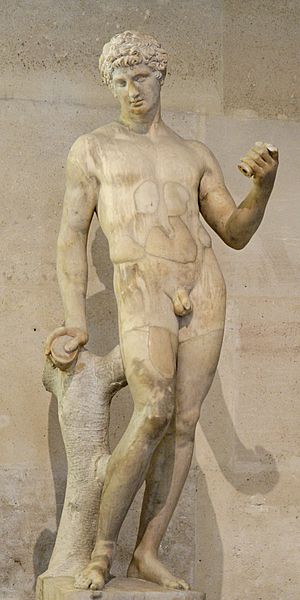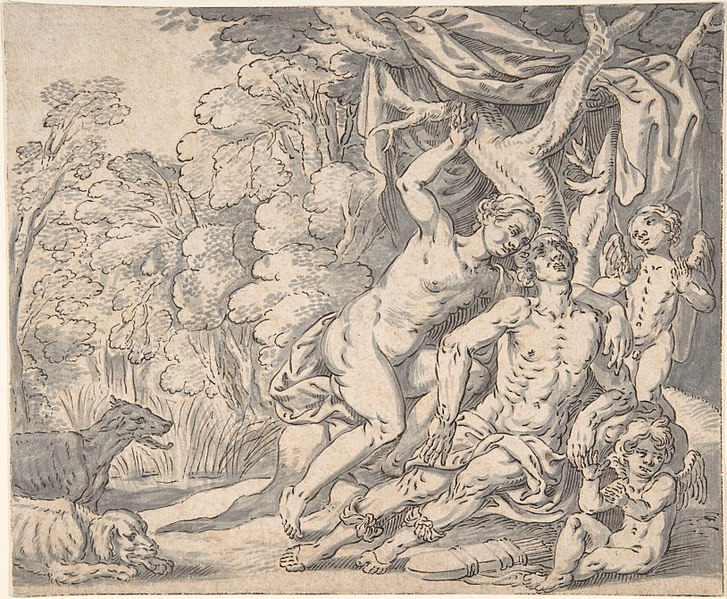Ah, Adonis! A name that has become synonymous with male beauty and desire. In this article, we’ll delve into the life, loves, and legacy of this captivating figure from Greek mythology.
Adonis Key Facts
| Keyword | Fact |
| Parents | Myrrha and Cinyras |
| Partners | Aphrodite, Persephone |
| Siblings | None |
| Offspring | None |
| Other names | None |
| Roman name | Adonis |
| The God of | Beauty and Desire |
| Symbols | Anemone, Rose |
Name and Etymology
The name “Adonis” is of uncertain origin, but it’s widely believed to have been derived from the Semitic word “Adon,” meaning “lord” or “ruler.” In Roman mythology, he retains the same name—Adonis—a testament to his universal allure.
Unlike other gods and heroes, Adonis didn’t have any epithets. His name alone was enough to encapsulate his essence: a demigod of extraordinary beauty and desire. The absence of other names or titles only serves to magnify the allure of his singular identity.
In the realm of etymology and nomenclature, Adonis stands unique. His name has transcended its origins to become a byword for male beauty. Even today, calling someone an “Adonis” is the ultimate compliment regarding physical attractiveness.

Adonis Origins
Adonis was born to Myrrha and her father Cinyras, King of Cyprus, in a tale steeped in tragedy and taboo. His birth was the result of a curse placed upon Myrrha, leading her to commit incest unknowingly. After discovering the horrifying truth, Myrrha was transformed into a myrrh tree, and from its trunk, Adonis was born.
His birth was extraordinary, to say the least. Aphrodite, captivated by his beauty even as an infant, took him under her wing. She placed him in a chest and entrusted him to Persephone, the queen of the Underworld, for safekeeping. However, Persephone was so taken by his beauty that she refused to give him back, leading to a divine dispute.
The role of Adonis in Greek mythology is complex. He embodies the spirit (Daemones) of beauty and desire but also serves as a cautionary figure. His life, though short-lived, had a profound impact on both gods and mortals, symbolizing the transient nature of beauty and the dangers of forbidden love.
Adonis Lovers and Relationships
Ah, love! The realm where Adonis truly made his mark. Let’s explore his most famous relationships.
Aphrodite and Adonis
Aphrodite, the goddess of love, was utterly captivated by Adonis. Their love was passionate but fraught with jealousy and competition, especially from Aphrodite’s other lovers. Adonis, however, seemed to have a particular fondness for Aphrodite, perhaps because she was his first love and protector.
Their relationship was not just physical but also emotional. Aphrodite found in Adonis a companion who was as beautiful as she was, a rarity in the divine realms. Their love was so intense that it even made the goddess of love neglect her divine duties, leading to a slight imbalance in the natural order.
Persephone and Adonis
Persephone, the queen of the Underworld, was the other significant figure in Adonis’ love life. She was so enamored by his beauty that she refused to return him to Aphrodite, leading to a celestial conflict. Eventually, Zeus had to intervene, decreeing that Adonis would spend one-third of the year with Aphrodite, one-third with Persephone, and the rest as he pleased.
The relationship between Persephone and Adonis was less passionate but more nurturing. Persephone saw in him a kindred spirit, someone who understood the duality of existence—beauty and decay, love and loss. Their time together in the Underworld was a period of mutual comfort and understanding.
Adonis Offspring
Interestingly, Adonis did not have any offspring, either divine or mortal. His life, though filled with love and desire, was cut short before he could leave a legacy in the form of children. This absence of offspring adds another layer of tragedy to his already poignant tale.
Depiction and Characteristics
Adonis is often depicted as the epitome of male beauty, usually shown as a handsome young man, sometimes with a spear or hunting dog, symbolizing his love for hunting.
His personality, as gleaned from myths, was one of complexity and duality. He was both lover and loved, captivator and captive. His actions spoke of a demigod who was aware of his beauty but also understood its transient nature.
In terms of powers, Adonis did not possess the typical divine abilities. His power lay in his extraordinary beauty, which could captivate both gods and mortals. This beauty, however, was also his downfall, leading to his untimely death during a hunting expedition.
Adonis is often associated with the anemone and the rose, flowers that are symbols of love and beauty. The anemone is said to have sprung from his blood when he died, while the rose was a gift from Aphrodite, dyed red by his blood.
Adonis Roles and Responsibilities
Adonis, being a demigod, did not have specific roles or responsibilities in the divine realm. However, he did serve as a symbol of beauty and desire, affecting both gods and mortals profoundly.
His life, though short, had a significant impact on the gods he was involved with, particularly Aphrodite and Persephone. His existence led to a temporary imbalance in the natural order, showing the disruptive power of extreme beauty and desire.
In a broader sense, Adonis serves as a cautionary tale about the fleeting nature of beauty and the dangers of forbidden love. His life and death remind us that even gods are not immune to the complexities and tragedies of love.
Myths about Adonis
The myths surrounding Adonis are as captivating as the demigod himself, each tale imbued with elements of love, beauty, and tragedy. Let’s delve deeper into these stories, beginning with his extraordinary birth, moving on to the celestial conflict over his custody between Aphrodite and Persephone, and finally, the tragic circumstances of his untimely death.
The Birth of Adonis
Adonis came into the world under circumstances most unusual and tragic. His mother, Myrrha, was cursed to fall in love with her own father, Cinyras, the King of Cyprus. This forbidden love led to an incestuous union, the discovery of which was so horrifying that Myrrha was transformed into a myrrh tree by the gods to escape her shame. From the fragrant trunk of this tree, Adonis was born, a radiant beauty emerging from a backdrop of sorrow and disgrace.
His birth was not just a mere event; it was a spectacle that even the gods took note of. Aphrodite, the goddess of love and beauty, was so entranced by the infant’s allure that she took immediate action to protect him, setting the stage for the next chapter in his life.
Aphrodite, Persephone, and the Custody Battle
Aphrodite, smitten by Adonis’ beauty, decided to take him under her divine protection. She placed the infant in a chest and gave it to Persephone for safekeeping in the Underworld. However, upon opening the chest and laying eyes on Adonis, Persephone too became captivated and refused to return him. What followed was a divine dispute that required the intervention of none other than Zeus, the king of the gods.
Zeus decreed a compromise: Adonis would spend one-third of the year with Aphrodite, another third with Persephone, and the final third wherever he chose. This arrangement was more than just a custody agreement; it symbolized Adonis’ dual nature as both an earthly and underworld figure, embodying themes of life, death, and rebirth.
The Tragic Death of Adonis
The final, and perhaps most famous, myth surrounding Adonis is his tragic demise. An avid hunter, Adonis was in the forest one day when he encountered a wild boar. The boar was no ordinary beast but was thought to have been sent by Ares, the god of war, one of Aphrodite’s jealous lovers. In the ensuing struggle, Adonis was fatally gored by the boar.
Aphrodite, hearing his cries, rushed to his side but arrived too late. In her grief, she transformed his spilled blood into the anemone flower. This transformation was not just a poetic gesture but a poignant reminder of the transient nature of beauty and life. The anemone, a delicate flower that blooms briefly and then withers, serves as an eternal symbol of Adonis, capturing both his breathtaking beauty and his tragic end.
Representations of Adonis in Art
Adonis has been a popular subject in art, often depicted in the embrace of Aphrodite or sometimes alone in all his beauty. One of the most famous artworks is “Venus and Adonis” by Titian, a painting that captures the love and tragedy that defined him.
Another significant piece is the sculpture “Adonis” by Gianbattista Tognolo, which beautifully captures his physical form, embodying the ideal of male beauty that has influenced art and culture for centuries.

Mentions in Ancient Texts
Adonis is mentioned in various ancient texts, most notably in Ovid’s “Metamorphoses,” where his birth and tragic love life are detailed. Written around 8 AD, Ovid quotes Aphrodite’s lament at Adonis’ death: “I could not save him, but he shall be famous forever.”
Another mention is found in the works of the poet Bion, who wrote a lament for Adonis, capturing the grief of Aphrodite. This text, written in the early 2nd century BC, serves as one of the earliest references to the demigod.
Frequently Asked Questions
Adonis is the demigod of beauty and desire.
He was born to Myrrha and Cinyras, under tragic circumstances.
Aphrodite and Persephone were the main figures in his love life.
No, Adonis did not have any offspring.
He was killed by a wild boar during a hunting expedition.
The anemone and the rose are symbols associated with Adonis, representing love and beauty.
Featured Image Credit: Titian, Public domain, via Wikimedia Commons
